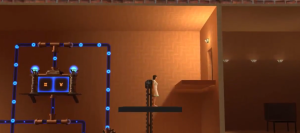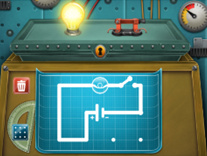Assignment final document (PDF version): Level1-assignmentv4
1: Blog Entry (Analyzing Games & Simulations)

- Game/Simulation Title #1: WIRED THE GAME
- What was the game/simulation about? This is a puzzle and platformer game. The characters involved are a young man who claims to have made this place, an older man, and a chap. Also, a strange young lady has an appointment outside the school, but she falls into a trap and has to go through all floors and challenges to escape and meet her host. The story involves electricity, mechanical machines, and physics phenomena.
- Describe the game’s/simulation’s structure: The player has to wire machines to access the next room. The player can activate a computer screen to get hints. They walk, jump, and climb ladders and connect sockets and wires to move panels out of the way or use them to bridge gaps. Some info pops up on the screen provided by the young man telling the story of the place.
- What did you enjoy/not enjoy while playing the game/simulation? The wires’ aesthetics disturbed me as they look more like plumbing or HVAC pipes, and in my line of work, we make sure to distinguish these and not mix them up. This game is missing the authentic, realistic environment for a serious game if that was the designer’s goal. In addition, electric wires are only used to close circuits, whereas mechanical machines can lift and move panels. Is this a game about mechanical engineering? It isn’t apparent.
- Would you classify this as a game, simulation game, or simulation? Why? Because the electrical engineering environment is unrealistic, the game does not involve simulation, except for some mechanical parts that could be used to simulate machines. According to researchers (Boller, 2014 Narayanasamy et al., 2006), this characteristic is essential to a simulation. Therefore this game is not a simulation game and not a simulation.
- Game/Simulation Title #2: CIRCUIT WARZ

-
- What was the game/simulation about? Earth is under attack. Weapons are broken. The player/learner has to solve a series of increasingly more difficult puzzles through the practical application of circuit theory under severe time constraints. Learning topics focus on fundamental electronic and electrical circuits. There are seven levels. Each level has one learning objective(s) and requires the application of a specific formula and analyzing the problem using a set of concepts. Education aspects are HERE. Training is available before playing the game, designed as an assessment. There are also multi-player and Virtual Reality implementations available.
- Describe the game’s/simulation’s structure: For each level, the player can view the HUD to assess the work to do, then walk to different sets of 3 or more components. The player can shoot with a sonic screwdriver to interact with components. They can rotate the group and activate the appropriate element (3D multiple choice mechanics). They then walk back to the console to verify the value achieved and score. The player can compare with the target provided and visualize the output signal. To improve the result, the player could think and calculate the best value and make the correct selection, or they can walk and guess and check or do a combination of both. There is no performance failure, but because time is of the essence, the player is under pressure to learn how to solve the problem asap.
- What did you enjoy/not enjoy while playing the game/simulation?
- I am a trained physics engineer, and the game did not provide a rich learning experience. First, I needed clarification on using movement mechanics (a gamification technique, according to Kapp (2012, chapter 8). An engineer uses psychomotor skills but not for walking to reach electronic components far apart. Also, the hand tool is used for selecting multiple-choice answers. This kind of interaction belongs to an instructional design paradigm but is only sometimes present in the real world. Therefore, it was the disconnect between the gameplay experience and training skills that I did not like.
- In addition, I felt the “fantasy” aspect was misaligned. I was not too fond of the aesthetic concepts of enormous components with a standard-size character. The other way around, a shrank player could move tiny components placed in an integrated circuit. The player could be walking around and using the weapon to solder things. The environment did not evoke what Malone cited by Kapp (2012, chapter 3), mentioned to produce mental images resonating “within the actual experience of the person involved” (p. 56).
- Would you classify this as a game, simulation game, or simulation? Why? According to Narayanasamy et al. (2006), simulators offer a realistic environment with an elaborate interface and no compromise on input. Therefore we would expect a “functional mock-up” (p. 13). However, this game features graphic objects that look like electronic components but are not at scale and are connected with wires that have some features like the real thing but not all. There is a background with an integrated circuit to suggest where these objects typically work, but the interactive components are not part of it. Finally, the mechanics of multiple choice is a typical learning feature but a relatively limited input choice for an actual simulation. This game presents aspects of simulating the functioning of electronic circuits but cannot qualify as a simulation game due to the lack of realism.
- Game/Simulation Title #3: CRACK THE CIRCUIT
- What was the game/simulation about? Observe a simple circuit with a bulb, battery, and switch. Underneath the circuit is a box hiding how components are connected. Players must experiment and try to figure out how the circuit is wired. We can draw and submit a sketch of the circuit diagram. You win when the diagram matches the actual circuit. There are 18 levels and a free draw mode with 4×3, 5×4, and 7×5 grids.
- Describe the game’s/simulation’s structure: The player must solve puzzles with the following specific core loop (concept defined by Eng, 2019):
- Observe an actual circuit having hidden mystery parts and click as instructed to get started.
- Guess and sketch the associated circuit diagram on a 3×4 grid. Draw wire lines and drag-and-drop components.
- When the diagram matches the actual circuit, a box opens underneath the circuit and reveals the hidden parts. You can go to the next level.
- When the diagram is incorrect, the box does not open, and you do not pass and must redo it until it is correct to pass.
- What did you enjoy/not enjoy while playing the game/simulation?
 1) The game contextualization provided some elements of fantasy and some functionality as the light bulbs react to a proper circuit diagram. I liked the short circuit red light and sound animation. These elements supported some of Lepper’s instructional design principles for intrinsic motivation, as described by Kapp (2012). But overall, the game design needs to include many other aspects. Because the game required to provide more control and the challenges were somewhat repetitive, my experience could have been more varied but instead was quite monotonous.
1) The game contextualization provided some elements of fantasy and some functionality as the light bulbs react to a proper circuit diagram. I liked the short circuit red light and sound animation. These elements supported some of Lepper’s instructional design principles for intrinsic motivation, as described by Kapp (2012). But overall, the game design needs to include many other aspects. Because the game required to provide more control and the challenges were somewhat repetitive, my experience could have been more varied but instead was quite monotonous.
2) There is no game-saving tool. Therefore, “distributed practice” is impossible. The game is “meant to be played in one sitting” (Kapp, 2012, p.65). Levels are locked and are only opened when the preceding is passed. In addition, replayability is limited as there is only one set of content, with no random input and no alternate path. Therefore, the game must include the benefits of spaced practice typically associated with multiple sessions to make it more attractive.
- Would you classify this as a game, simulation game, or simulation? Why?The game “CRACK THE CIRCUIT” involves simulation for sketching a circuit diagram. The diagrams created are realistic, symbols are correct. According to Boller (2014), simulations focus on problem-solving and guide learners with making decisions that “mimic what you would have to do in the real world” (para. 5). Lights go on when appropriately connected, and circuit burns if shorted. The option to work with different grids to choose from makes the simulation even more realistic. However, the game has hidden parts of the actual circuit, adding a gaming and mystery component. In addition, there exists a win/lose end-state. For all these reasons, this game classifies not just as a simulation but a simulation game.
REFERENCES
Boller, S. (2014). Games vs Simulations: Choosing the Right Approach for Learning Links to an external site. Retrieved from the Knowledge Guru.
Boller, S. & Kapp, K. (2017). Chapter 1 The Basics. In Everything You Need to Know About Designing Effective Learning Games Play to Learn. pp. 6-8
Eng, D. (Dec. 2, 2019). Core Loops. Retrieved from https://medium.com/@davengdesign/core-loops-c98b1197e93d
Kapp, K.M. (2012). Chapter 3 – Theories behind gamification of learning and instruction. In The gamification of learning and instruction: Game-based methods and strategies for training and education. San Francisco, CA: Pfeiffer.
Narayanasamy, V., Wong, K. W., Fung, C. C., & Rai, S. (2006). Distinguishing games and simulation games from simulators. Computers in Entertainment (CIE), 4(2), 9-es